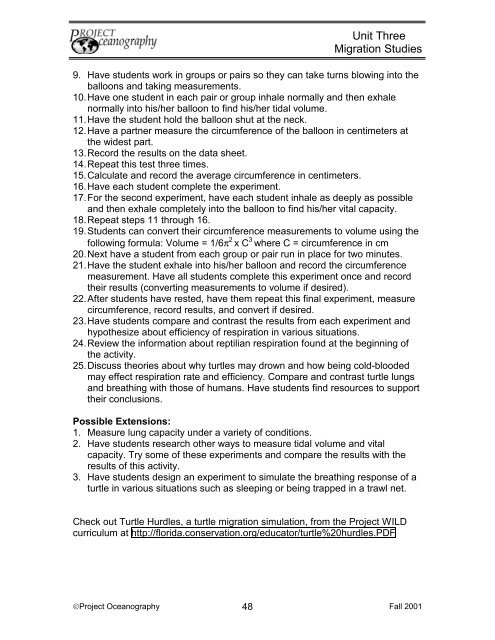Sea Turtles
Sea Turtles
Sea Turtles
You also want an ePaper? Increase the reach of your titles
YUMPU automatically turns print PDFs into web optimized ePapers that Google loves.
Unit Three<br />
Migration Studies<br />
9. Have students work in groups or pairs so they can take turns blowing into the<br />
balloons and taking measurements.<br />
10. Have one student in each pair or group inhale normally and then exhale<br />
normally into his/her balloon to find his/her tidal volume.<br />
11. Have the student hold the balloon shut at the neck.<br />
12. Have a partner measure the circumference of the balloon in centimeters at<br />
the widest part.<br />
13. Record the results on the data sheet.<br />
14. Repeat this test three times.<br />
15. Calculate and record the average circumference in centimeters.<br />
16. Have each student complete the experiment.<br />
17. For the second experiment, have each student inhale as deeply as possible<br />
and then exhale completely into the balloon to find his/her vital capacity.<br />
18. Repeat steps 11 through 16.<br />
19. Students can convert their circumference measurements to volume using the<br />
following formula: Volume = 1/6π 2 x C 3 where C = circumference in cm<br />
20. Next have a student from each group or pair run in place for two minutes.<br />
21. Have the student exhale into his/her balloon and record the circumference<br />
measurement. Have all students complete this experiment once and record<br />
their results (converting measurements to volume if desired).<br />
22. After students have rested, have them repeat this final experiment, measure<br />
circumference, record results, and convert if desired.<br />
23. Have students compare and contrast the results from each experiment and<br />
hypothesize about efficiency of respiration in various situations.<br />
24. Review the information about reptilian respiration found at the beginning of<br />
the activity.<br />
25. Discuss theories about why turtles may drown and how being cold-blooded<br />
may effect respiration rate and efficiency. Compare and contrast turtle lungs<br />
and breathing with those of humans. Have students find resources to support<br />
their conclusions.<br />
Possible Extensions:<br />
1. Measure lung capacity under a variety of conditions.<br />
2. Have students research other ways to measure tidal volume and vital<br />
capacity. Try some of these experiments and compare the results with the<br />
results of this activity.<br />
3. Have students design an experiment to simulate the breathing response of a<br />
turtle in various situations such as sleeping or being trapped in a trawl net.<br />
Check out Turtle Hurdles, a turtle migration simulation, from the Project WILD<br />
curriculum at http://florida.conservation.org/educator/turtle%20hurdles.PDF<br />
©Project Oceanography 48<br />
Fall 2001
















